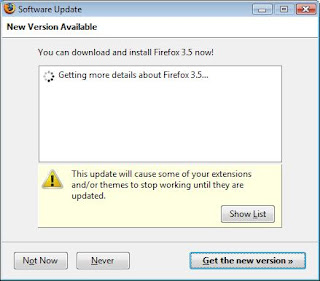Your operating system isn't the only software you need to keep patched. (Read More on Managing Windows Update To Keep Your Computer Safe) In the old days, users commonly had to find third-party security updates on their own. In more-recent years, however, as criminal hackers have begun targeting common desktop applications, vendors of multimedia apps in particular have gotten better at pushing out their own security patches.
Related Links:
Solve Problems Caused By Windows Update | Restore Installed Updates
Managing Windows Update To Keep Your Computer Safe
Update Windows Manually | Skip Automatic Updates
Take Control Of Problems In Windows 7 With Action Center
Disable Windows Defender Automatic Operations
Managing Windows Update To Keep Your Computer Safe
Update Windows Manually | Skip Automatic Updates
Take Control Of Problems In Windows 7 With Action Center
Disable Windows Defender Automatic Operations
Here's a look at the update process for some common types of desktop software.
Firefox: Mozilla silently and automatically downloads its browser security updates in the background; Firefox then installs the update the next time you launch the browser. You can check for updates whenever you want by clicking Help, followed by Check for Updates.
Full-version updates (say, an upgrade from Firefox 2 to Firefox 3), however, still require a clean installation from Mozilla.
Apple Software Update: click for full-size image
iTunes and QuickTime: Whenever you launch an Apple application within Windows, Apple does a quick check and then notifies you of the latest release for iTunes or QuickTime (if you aren't already running it).
You can also request a update by clicking Help, and then Check for Updates. Occasionally, Apple will push out a notification of a new security update for iTunes and/or QuickTime. When it does, a dialog box will pop up to explain what the update includes. Unfortunately, Apple has been known to bundle other offerings--such as Safari and Bonjour for Windows--with these updates, regardless of whether you already have these apps installed. If you don't want these extra programs, simply uncheck their boxes before installing the update.
Flash and Adobe Reader: Adobe, like Apple, pushes out security updates as they are completed and issued. Alternatively you can request a update check by clicking Help, and then Check for Updates.
In general, you can expect legitimate requests from Adobe to install new updates to appear shortly after you boot into Windows; you should take the opportunity then to install them.
Java: Sun recently ran afoul of security researchers who discovered that insecure older versions of Java remained on the Windows machine the researchers installed newer, more secure versions of Java.
With JRE6 Update 10, Sun now removes older versions of Java, but it doesn't remove any pre-Update 10 versions; you'll have to uninstall these yourself. (Note: Not all PC users have Java installed on their desktop; don't feel bad if your system is Java-less.)
Related Posts:





